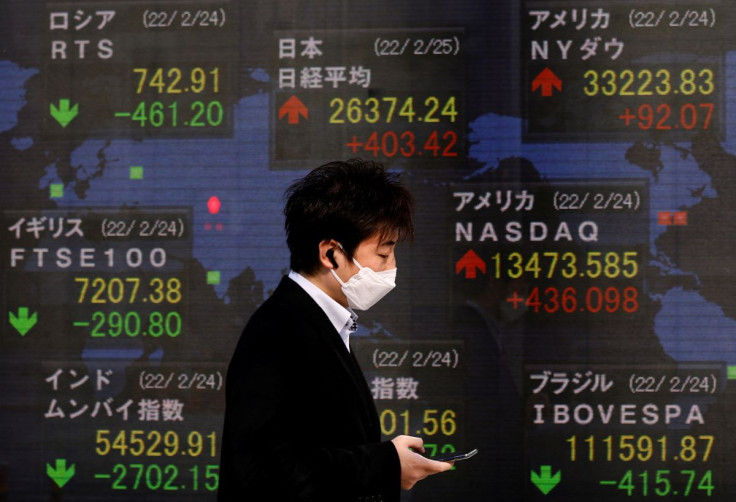Stocks Make Tentative Start To Second Half Under Growth Clouds

Bonds slipped, the dollar edged higher and Asia's stockmarkets made a shaky start to the second half on Friday, as investors grow increasingly nervous about the global economic outlook.
MSCI's broadest index of Asia-Pacific shares outside Japan was flat, with trade thinned by a holiday in Hong Kong.
Japan's Nikkei slipped 0.7%. Treasuries fell, lifting yields a little bit along the curve, and U.S. equity futures dropped about 0.2%. [.T][US/][.N]
The S&P 500 closed out its worst first-half since 1970 overnight and the Treasury market has taken such a beating in the past six months that Deutsche Bank estimates the performance is the poorest in more than two centuries.
Inflation and central banks' response to it is responsible. Focus is now on any clues about whether it has peaked. Eurozone consumer price data is due later on Friday and July figures in the United States will be a blockbuster for financial markets.
German inflation unexpectedly slowed last month, as did the pace of U.S. consumer spending in May, according to data released on Thursday - prompting some pullback in rate-hike bets but at the same time increasing worries about economic weakness.
"Many investors want a clear outlook," said Steven Wieting, chief investment strategist at Citi Global Wealth Investments, but the future does not present a steady, reliable recovery.
"(2020) was a clear period where the economy was depressed that we could put money to work here with a lot of confidence. We can't say that now," he said.
Growth worries punched oil lower and Brent crude futures were last at $109.76 a barrel. [O/R]
The uncertainty has kept a bid behind the U.S. dollar, even as markets have pulled back on aggressive interest-rate forecasts and have lately even priced Federal Reserve rate cuts as soon as mid-2023.
The dollar had its best quarter since 2016 for the three months to the end of June and the euro and yen were losers. The greenback was firm on Friday and heading for a weekly gain, with the dollar index up 0.7% on the week to 104.830. [FRX/]
CHINA BRIGHT
Amid the gloom, however, China has suddenly become a bright spot. Mainland markets rose in the last quarter and have bounced about 20% from April lows.
China is emerging from lockdown, has no inflation problem and this week factory activity data showed a welcome return to growth, with Caixin PMI data on Friday showing June brought the fastest expansion in manufacturing in 13 months.
The Shanghai Composite and blue-chip CSI300 edged about 0.3% lower on Friday but they are each set to log five straight weeks of gains. [.SS]
The yuan has steadied and that has leant somewhat of a hand to some regional currencies, even if the dollar remains in demand. Friday's focus was on Chinese President Xi Jinping's visit to Hong Kong.
Among majors the dollar rose to $1.0469 per euro and was up about 0.3% to $0.6883 on the Aussie. [AUD/]
It bought 135.64 yen after a blistering 11.6% rise over the June quarter. The strong dollar and rising U.S yields have kept a lid on gold, which pays no yield, and it was drifting toward a weekly loss at $1,805 an ounce on Friday.
Another notable outperformer in Asia has been Indonesia, where stocks are up more than 5% for the year and could benefit further if foreign money does flow back to emerging markets. [.SO]
"While clients remain more in risk reduction mode, at some point there's a weight of money to come back into the asset class," said David Beale, vice chair of global emerging markets' institutional client coverage at Deutsche Bank in Singapore.
"Clearly any signs of inflation plateauing and rate hikes starting to be priced out could signal a more favourable path," he said. "Next month's U.S. CPI print will be critical in this regard."
(Editing by Shri Navaratnam)
© Copyright Thomson Reuters 2024. All rights reserved.




















